Flow Regimes, Erosion Regimes, and other Sedimentary Structures
1/42
There's no tags or description
Looks like no tags are added yet.
Name | Mastery | Learn | Test | Matching | Spaced |
|---|
No study sessions yet.
43 Terms
Other ways to describe low energy system
Low velocity, distal
Other ways to describe high energy systems
High velocity, proximal
Sand ripples in lower-lower flow regime
Small straight crested ripples, linguloid ripples
Sand ripples in upper-lower flow regime
Large straight crested ripples, lunate ripple
Cross laminations in lower-lower flow regimes
Small planar cross beds, small trough cross beds
Cross beds found in upper-lower flow regimes
Large planar cross beds, large trough cross beds
Lunate ripples form what crossbeds?
Large trough cross beds
Large straight crested ripples form what crossbeds?
Large planar cross beds
Small straight crested ripples form what crossbeds?
Small planar cross beds
Linguloid ripples for what kind of crossbed?
Small trough cross beds
Bed forms from upper flow regimes?
Plane beds, anti-dunes, chute and pool
Bed forms in no deposition/erosion regimes?
Flute/Tool Marks, scours, channels
Internal structures in no deposition/erosion regimes?
Sediment channel fill
List Flow Separation Zones in order (top to bottom ).
Zone of no diffusion, zone of diffusion, zone of backflow.
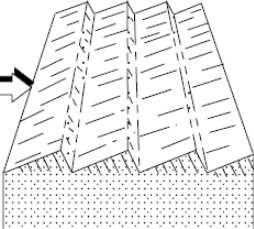
What kind of ripples are these? What flow regimes do they form in?
Small straight crested ripples, Lower-lower flow regimes
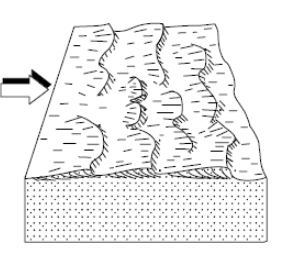
What kind of ripples are these? What flow regimes do they form in?
Linguloid ripples, lower-lower flow regimes
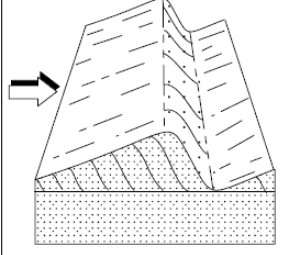
What kind of ripples are these? What flow regimes do they form in?
Large straight crested ripples, upper-lower regimes
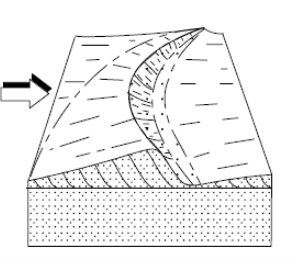
What kind of ripples are these? What flow regimes do they form in?
Lunate ripples, upper-lower flow regime
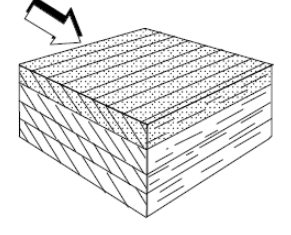
What kind of cross beds are these? What ripples do they form from?
Small planar cross beds, Small straight crested ripples
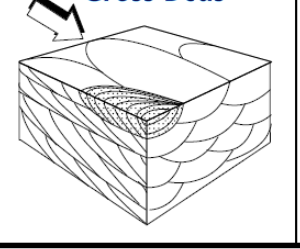
What kind of cross beds are these? What ripples do they form from?
Small trough cross beds, linguloid ripples
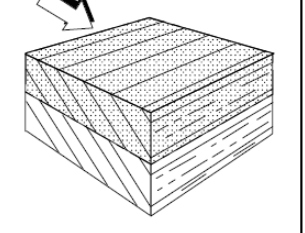
What kind of cross beds are these? What ripples do they form from?
Large planar cross beds, large straight crested ripples
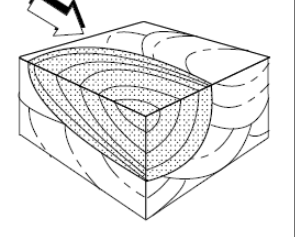
What kind of cross beds are these? What ripples do they form from?
Large trough cross beds, lunate ripples
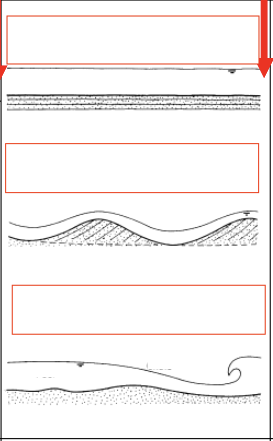
Name, in order, all of these upper flow regime ripples.
Plane bed, anti-dunes, chute & pools
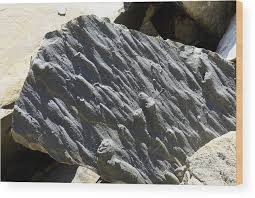
What are these?
Flute marks
Very low energy flow, undetectable, doesn’t show up in geological timescales.
Laminar flow
As energy picks up this forms; once it touches the bottom of a bed it picks up sediment and erodes it. Forms troughs
Scouring Vortex/Eddie
The upstream facing side of a crest.
Stoss
The downstream facing side of a crest.
Lee/Slip face
Water ripples match sand ripples, sand grains move together in a ‘haze’ forming flat laminations parallel to the water
High Velocity Laminations/Plane Beds
Extremely high velocity (can’t stand in), form curved laminations matching the waves.
Antidunes
Not all in phase with each other, large volume of water on one side with a small body on the other side — velocity increases as the large body of water flows into the small body of water, causes upstream wave breaks.
Chute & Pool
Rocks get picked up in rapid floods and move down stream quickly, forms point bars and cut banks.
Scours & channels
Formed by rip currents.
Shelf Scours/Gutters
Carves made into laminations
Scours
Made by an avalanche of sand when it’s disturbed at criticality, flowing down a slope. Scours into the previous sediment base, with sand filling that scour.
Flute Marks
Marks indicating that something something was being carried through the water.
Groove Marks
Water only flowing in one direction on terrestrial planes.
Unidirectional Flow
Energy of the water changes (ie. waves going back and forth).
Oscillatory Flow
When two different directions of energy change the way the water flows.
Combination Flow
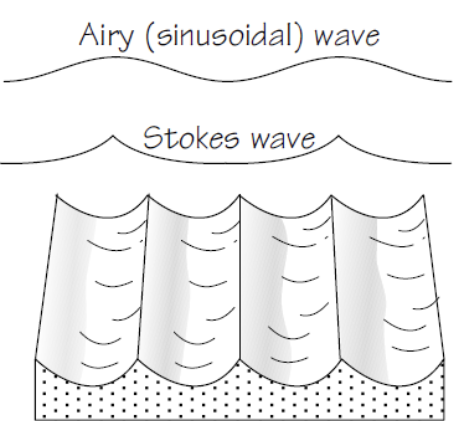
What kind of flow do these waves follow?
Pure oscillatory flow
Waves that are symmetrical, can be found in pure oscillatory ripples. Sand ripples match these (2).
Stokes waves, sinusodal
Bundles of thickening and thinning stratifications, the bundles cutting into each other. The surface has small domes and swales. Forms in storm shelf environments.
Hummocky cross stratification